Physical Address
304 North Cardinal St.
Dorchester Center, MA 02124
A proliferative and necrotizing abnormality of the glomeruli ▸ it is usually primarily renal but may be part of a systemic vasculitis (e.g. SLE, PAN, Goodpasture's or Wegener's)
Acute: symmetrically swollen kidneys ▸ no papillary or calyceal abnormality
Chronic: small kidneys ▸ smooth, normal pelvicalyceal systems ▸ prominent renal sinus fat
Deposition of cellular debris within the tubules causing a reversible acute oliguric renal failure ▸ it usually follows an episode of severe ischaemia associated with hypotension, dehydration, or nephrotoxin exposure
Swollen kidneys ▸ increased echogenicity within the cortex and pyramids
A persistent nephrogram ▸ little or no filling of the pelvicalyceal system
Ischaemic necrosis of the cortex (with sparing of the medulla and medullary pyramids) causing irreversible renal damage ▸ the insult is more severe than that seen with ATN and is usually due to obstetric shock
Patchy or linear renal calcification (with a ‘pencil line’ or ‘double tramline’ appearance)
Acute: a hypoechoic renal cortex ▸ chronic: cortical calcification
There may be opacification of the spared subcapsular cortex (its blood supply is from capsular vessels)
Ischaemic necrosis involving the renal medullary pyramids and papillae (these regions are particularly sensitive to hypoxia)
Causes: analgesic abuse ▸ diabetes ▸ sickle-cell disease or trait ▸ obstruction complicated by infection ▸ acute infection ▸ haemophilia ▸ renal vein thrombosis ▸ acute renal failure in infancy
There is usually bilateral symmetrical involvement – unilateral involvement can occur with ascending infection or renal vein thrombosis ▸ the papillary and calyceal changes are rarely uniform
Acute: enlarged affected kidneys
Chronic: renal atrophy with a regular type of surface scarring (due to atrophy of the cortex overlying the damaged papillae and hypertrophy of the intervening columns of Bertin)
Calyces:
‘Lobster claw deformity’: initially the necrotic areas erode the papilla tip and excavate from the fornices into the pyramids
‘Egg in cup’ appearance: with progression contrast curves around the papilla from both fornices
Papillae: the papilla initially swells and may eventually slough into the pelvicalyceal system causing colic, haematuria or hydronephrosis (as it appears as a filling defect it can mimic tumour, calculus or a blood clot) ▸ if the papillae fail to separate (necrosis in situ) the calyces may appear normal ▸ the papillae may calcify (with spotty calcification in a ring or triangle around a translucent centre)
Remaining defect: calyceal clubbing resulting from a flattened or concave pyramidal tip
A common benign collecting duct ectasia occurring within the renal pyramids ▸ it is usually bilateral (but can be unilateral or segmental)
Medullary nephrocalcinosis: punctate medullary calcification (representing small calculi within ectatic tubules)
A striated nephrogram: multiple linear or saccular contrast collections within the medulla (do not confuse with a normal papillary blush)
Associations: Wilms' tumour ▸ phaeochromocytoma ▸ horseshoe kidney ▸ Caroli's disease ▸ hemihypertrophy
An increased number of calyces (polycalycosis) or calyces with an abnormal rounded shape (megacalycosis)
Focal parenchymal loss with clubbing of the underlying calyces – it usually follows a childhood infection associated with reflux
Small kidneys ▸ cortical scarring (representing parenchymal loss) with underlying clubbed calyces ▸ localized scars are more common within the upper pole (R>L)
It can be unilateral or bilateral with part or all of the kidney involved (± a dilated renal pelvis and ureters)
Deposition of calcium within the renal parenchyma and outside of the pelvicalyceal system
Medullary nephrocalcinosis (95%) : this is usually the product of a metabolic disorder (e.g. hyperparathyroidism/renal tubular acidosis) resulting in a raised serum calcium or a tubular defect resulting in hypercalciuria ▸ calcification is usually bilateral and diffuse
Cortical nephrocalcinosis (5%) : this is seen in acute cortical necrosis of any cause ▸ calcification is usually punctate and patchy (classically with a ‘tramline’ appearance)
| Glomerulonephritis ▸ acute tubular necrosis ▸ acute cortical necrosis | No papillary or calyceal abnormality ▸ no focal cortical loss |
| Papillary necrosis ▸ medullary sponge kidney ▸ megacalycosis/polycalycosis | Papillary or calyceal abnormality ▸ no focal cortical loss |
| Obstructive nephropathy ▸ focal reflux nephropathy | Papillary or calyceal abnormality ▸ focal cortical loss |
| Site | Cause |
|---|---|
| Cortical | Acute cortical necrosis |
| Medullary | Associated with a metabolic disorder Hyperparathyroidism Sarcoidosis Drug related (e.g. hypervitaminosis D, milk-alkali syndrome) Myelomatosis Primary or secondary hyperoxaluria Hyperhyroidism Osteoporosis |
| Associated with renal tubular defects Idiopathic hypercalciuria Medullary sponge kidney Renal tubular acidosis |
|
| Focal | Linear or rim calcification Renal artery aneurysm Real cyst |
| Amorphous calcification Calcified haematoma Tuberculosis Renal cell carcinoma (in 10%) Calcified renal papilla |
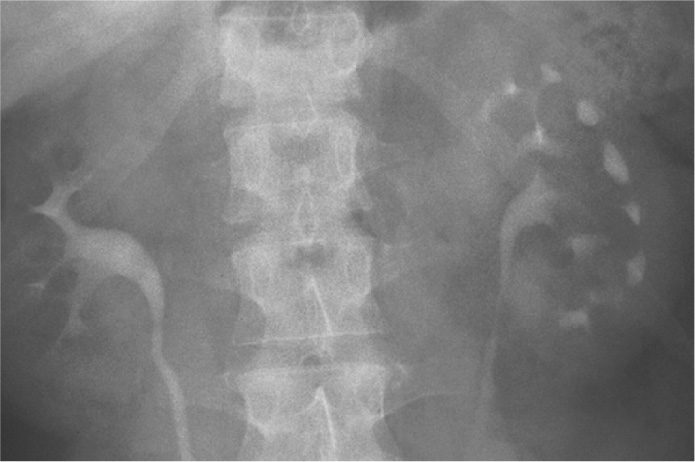
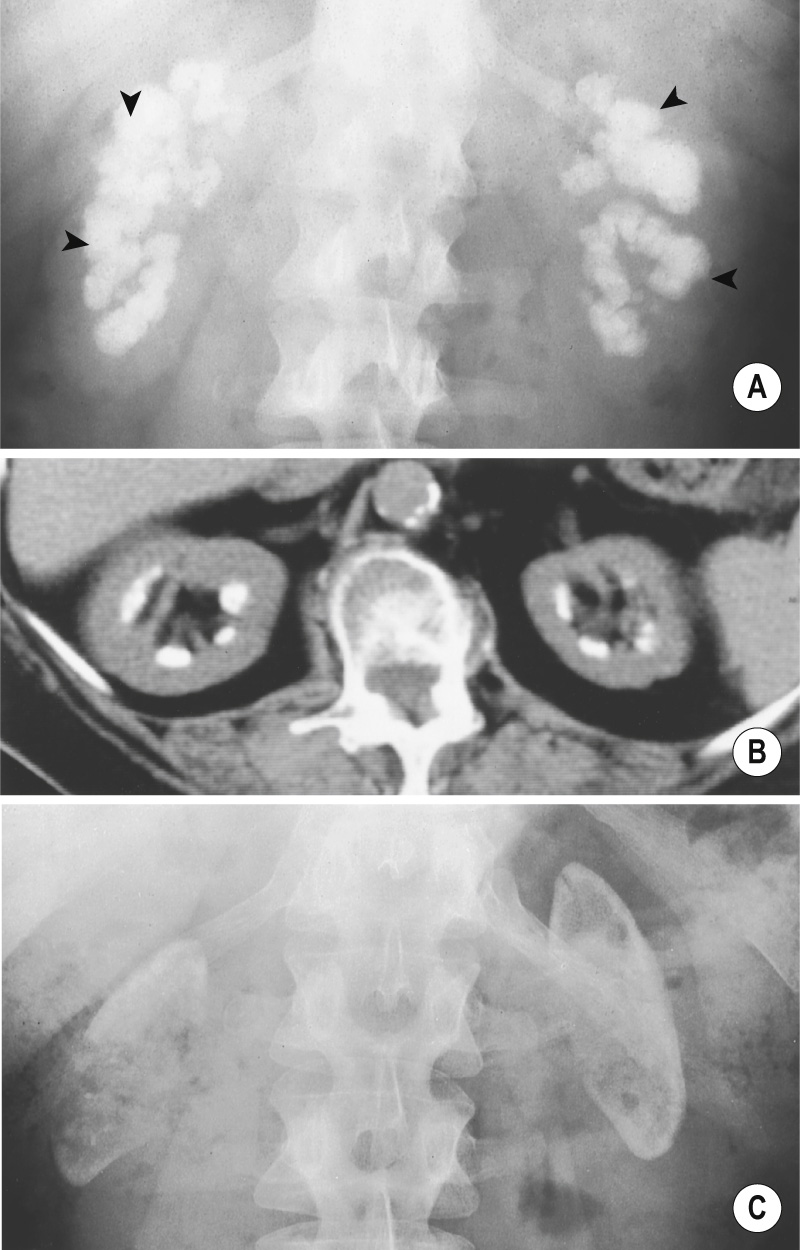
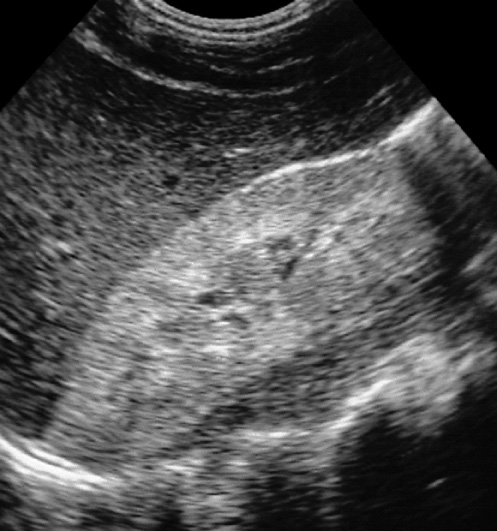
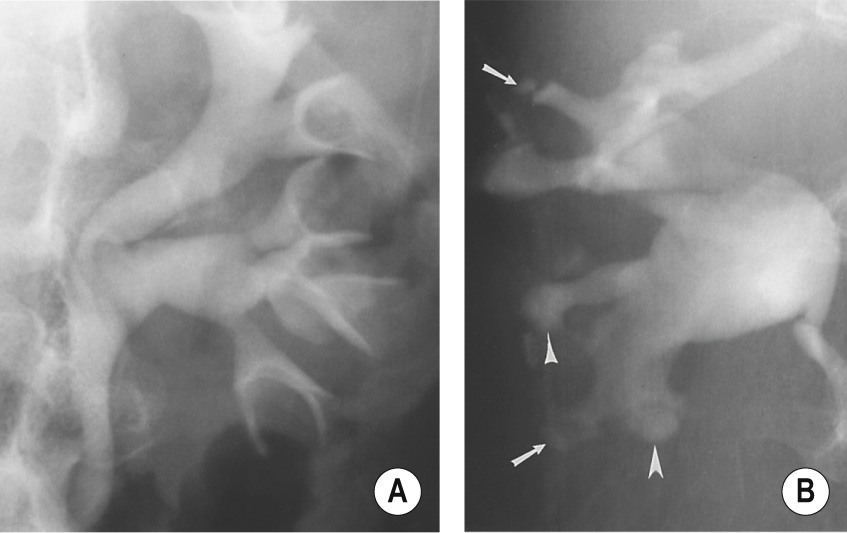
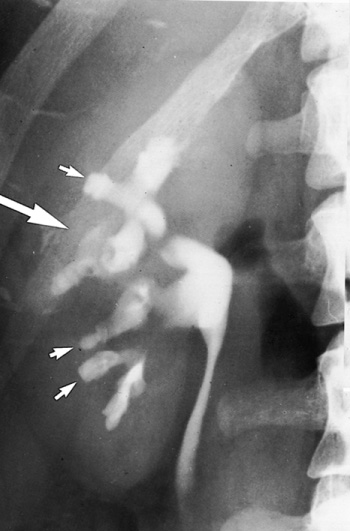
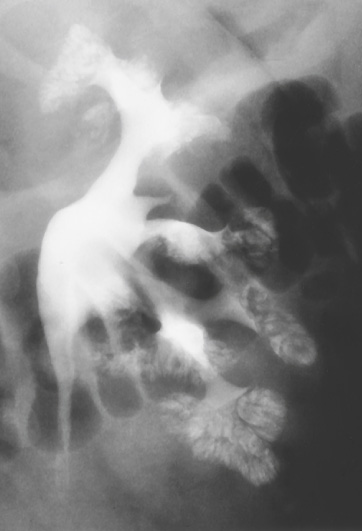
Bacteriuria, pyrexia and flank pain due to an ascending infection in 85% (usually E. coli ), or haematogenous seeding in 15% ( S. aureus )
Risk factors: diabetes ▸ vesicoureteric reflux (VUR) ▸ urinary obstruction ▸ pregnancy ▸ instrumentation ▸ immune deficiency
Extrarenal extension in diabetes/immunocompromised patients
This is a clinical diagnosis – imaging is rarely required during uncomplicated adult disease ▸ it can however be useful if the diagnosis is in doubt or to exclude obstruction or abscess development
Focal or diffuse renal swelling ▸ delayed and poor pelvicalyceal system filling ▸ a dense, persistent or striated nephrogram (with severe disease)
Normal in 80% ▸ focal (lobar) renal swelling or diffuse renal swelling with severe disease ▸ the affected segments are hypoechoic (they can be hyperechoic with haemorrhage) ▸ reduced corticomedullary differentiation (due to oedema) ▸ focal or diffuse reduced perfusion
Reduced renal attenuation (which can be increased with haemorrhage) ▸ renal swelling with acute disease
During the nephrographic phase there can be areas of patchy enhancement or band/wedge-shaped areas of decreased enhancement extending from the papillae to the renal margin ▸ delayed persistent enhancement ▸ any abnormal parenchymal enhancement may persist for >2 months and may develop into a scar ▸ extrarenal extension
Similar features as for CT
Can demonstrate areas of chronic scarring
Complications: abscess formation ▸ emphysematous pyelonephritis ▸ xanthogranulomatous pyelonephritis ▸ cortical atrophy and renal failure
Causes of a sterile pyuria: TB ▸ fungal infections ▸ glomerulonephritis ▸ interstitial nephritis
Renal abscess: usually due to ascending infection ( E. coli ) ▸ haematogeneous spread due to S. aureus
CT: non-enhancing fluid centre ± gas ▸ thick irregular wall ± enhancement ▸ inflammatory changes in the perinephric space
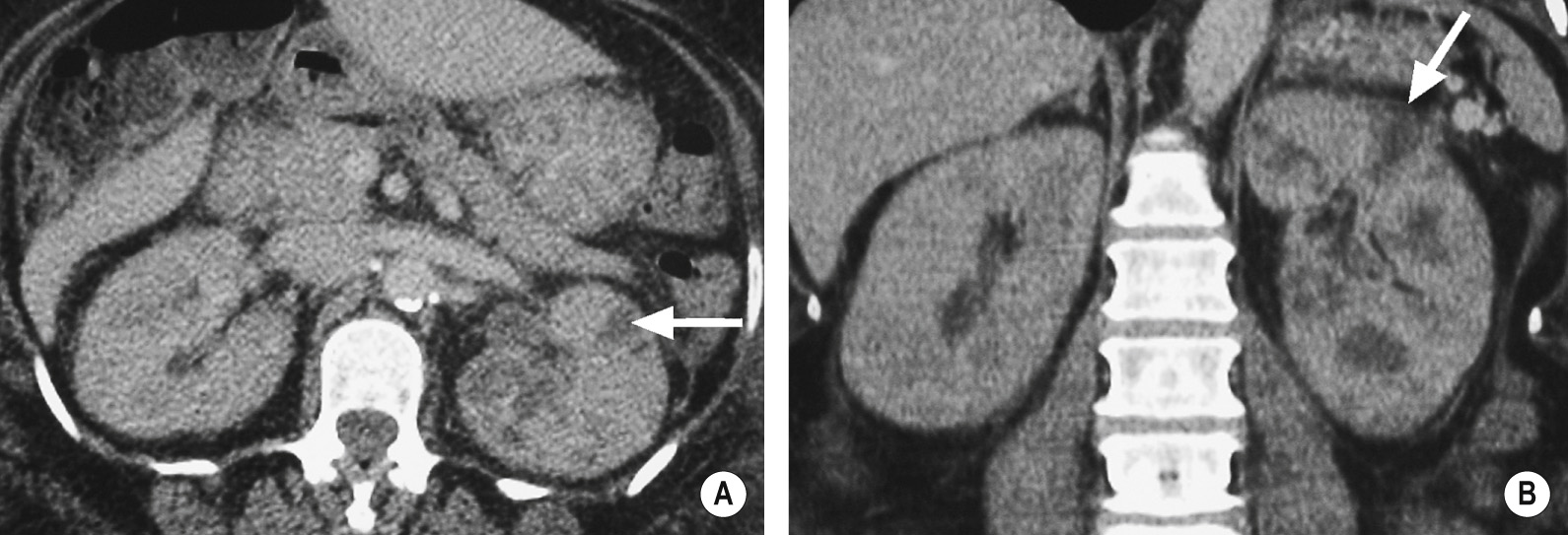

The kidneys are the 2 nd commonest site of TB involvement after the lung (even though the CXR is normal in 35–50% of cases it usually follows haematogenous spread from the lung)
Lesions spread via the tubular lumen to the papilla and hence to the collecting system ▸ papillary ulceration occurs early, with later spread to the collecting system leading to fibrosis and stricture formation
Lower tract symptoms ▸ haematuria ▸ sterile pyuria
Although both kidneys are seeded, clinical manifestations are usually unilateral (>70% of cases)
Early: an enlarged kidney ▸ irregularity and destruction of ≥1 papillae (resembling papillary necrosis)
Late: an atrophic kidney
Renal calcification (30%): this appears as punctate or curvilinear renal parenchymal calcification or as calcification within a caseous pyonephrosis (with a characteristic cloudy appearance in the distribution of the dilated calyces)
‘Tuberculous autonephrectomy’: this may progress to homogeneous calcification within a dilated pelvicalyceal system so that the kidney appears as a lobulated calcified mass
Ureteric calcification: this is the 2 nd commonest site of calcification with a typical beaded appearance ▸ calcification of the bladder, vas deferens and seminal vesicles is rarely seen
Cavitations: these are usually irregular and communicate with the collecting system ▸ widespread cavitations may mimic hydronephrosis (but the pelvis and infundibula of the calyces are not dilated unless there is an associated obstruction)
Fibrotic strictures: these can occur anywhere within the renal tract
Hydrocalycosis: a local calyceal dilatation due to a partial stricture of a major infundibulum (the infundibulum appears ‘cut off’ with a complete stricture) creating a ‘phantom calyx’
Ureter: a ‘corkscrew’ appearance (due to multiple stenoses) ▸ a ‘pipestem’ appearance (due to a rigid and aperistaltic ureter)
Renal pelvis: a ‘purse string’ stenosis
Bladder:
Early: trabeculation ▸ bladder wall irregularity ▸ a slight decrease in capacity
Late: a thick-walled small-capacity bladder demonstrating calcification ▸ bladder TB is almost always associated with renal TB ▸ often there is VUR into a widely dilated upper tract
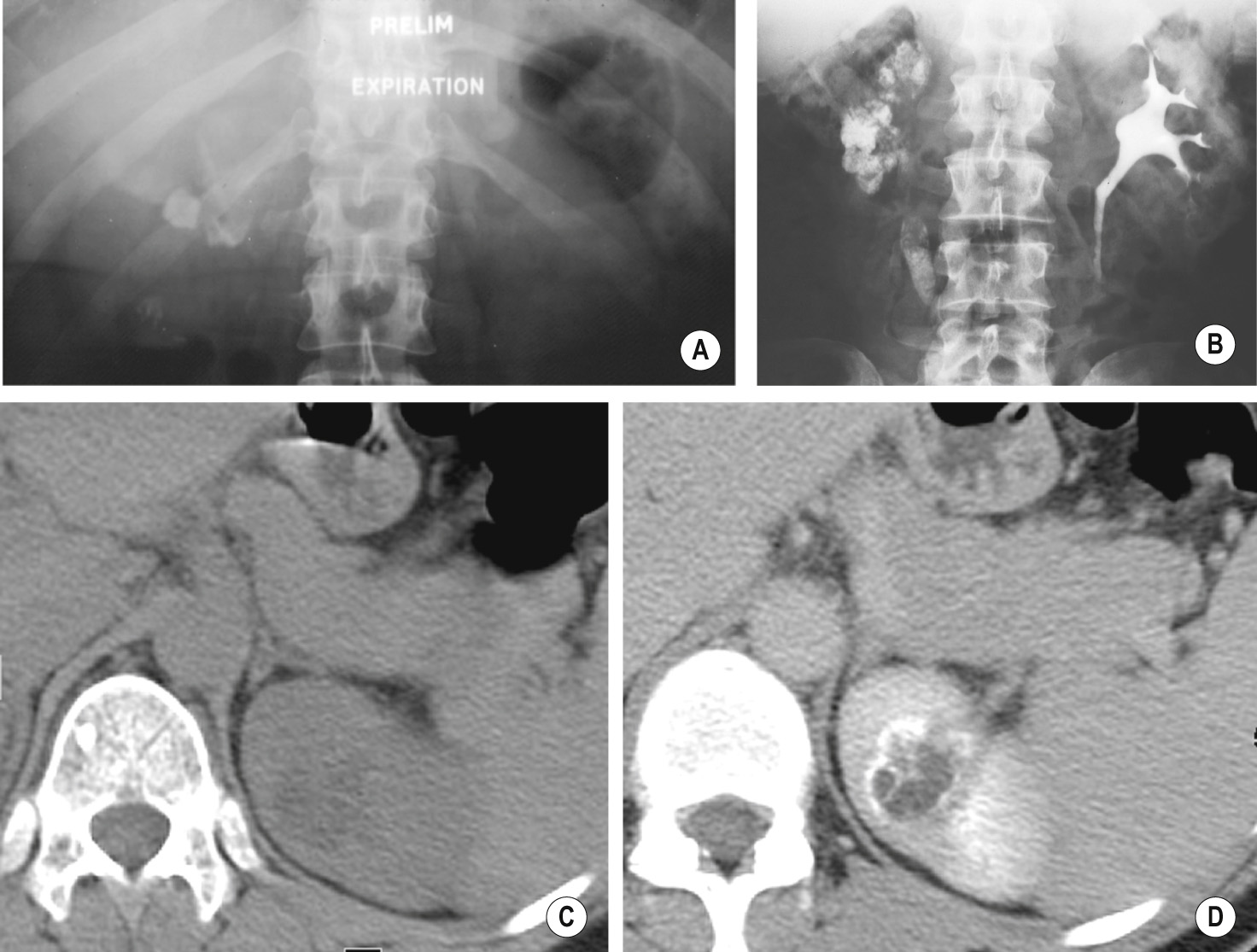
A rare fulminating form of acute necrotic pyelonephritis due to a gas-producing organism (usually E. coli ) ▸ it is associated with diabetes and obstruction
Gas within the renal parenchyma (which can be focal or diffuse) + the collecting system ± the perinephric space ▸ there is a high mortality rate (>60%) and it may require nephrectomy
Gas within the pelvicalyceal system and ureter only ▸ it has a lower mortality rate, and percutaneous drainage and antibiotics may be sufficient
Gas within the perinephric space
Gas within the bladder and bladder wall (due to E. coli or C. albicans ) ▸ the patient is usually diabetic

Chronic renal parenchymal inflammation with replacement of the normal renal parenchyma with lipid-laden histiocytes ▸ it is secondary to chronic urinary infection (e.g. E coli or Proteus mirabilis ) and obstructing calculus disease ▸ it is associated with diabetes ▸ renal pelvis initially affected, later corticomedullary areas are affected (± peri-renal extension)
There are diffuse (common) or focal (uncommon) forms ▸ the focal form can mimic a tumour
A renal staghorn calculi (70%) ▸ an enlarged (global or focal) non-excreting kidney ▸ dilated affected calyces with internal echoes or debris ▸ a heterogeneous kidney with multiple non- or rim-enhancing low attenuation areas (-15 to -20 HU) representing dilated calyces and xanthomas ▸ perinephric extension (± a thickened Gerota's fascia) is common ▸ hilar/para-aortic adenopathy
Necrotic areas are hyperintense on T2WI ▸ T1WI: intermediate SI (high protein content within cavities)
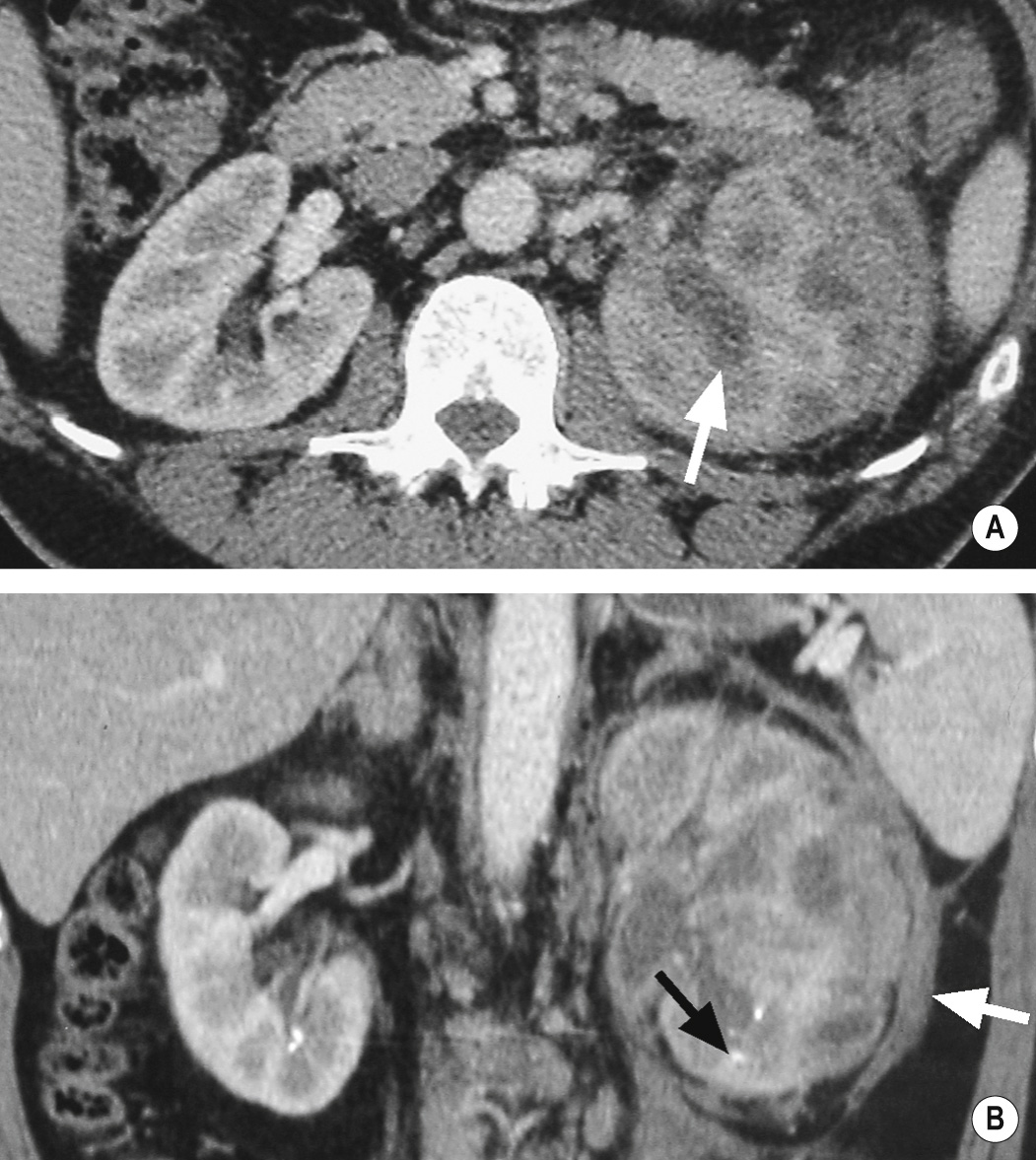
A renal parenchymal collection secondary to acute pyelonephritis (Gram-negative or anaerobic bacilli) or haematogenous spread of infection ( S. aureus )
A heterogeneous renal mass with areas of cystic necrosis (± shadowing due to gas)
There is a heterogeneous central portion of near-fluid density (with no enhancement) ▸ there are enhancing thick irregular walls (± perinephric inflammatory change) ▸ gas within the lesion is diagnostic
T1WI: low SI rounded thick walled lesion ▸ T2WI: high SI depending on fluid/debris content ▸ T1WI+Gad: rim enhancement
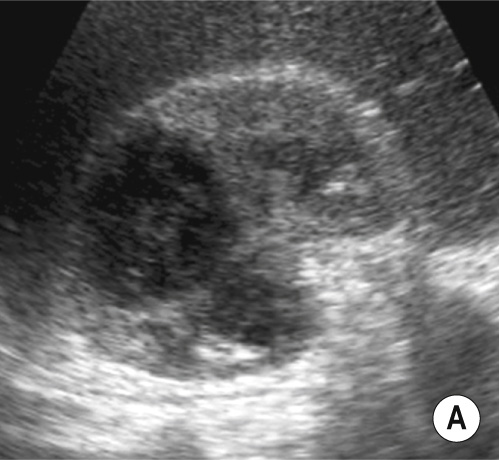
An extension of renal infection into the perinephric space with subsequent abscess formation
Loss of the renal outline (± psoas shadow) ▸ absent renal function
A perinephric rim-enhancing fluid collection (± debris, septations and gas) ▸ this may extend in any direction
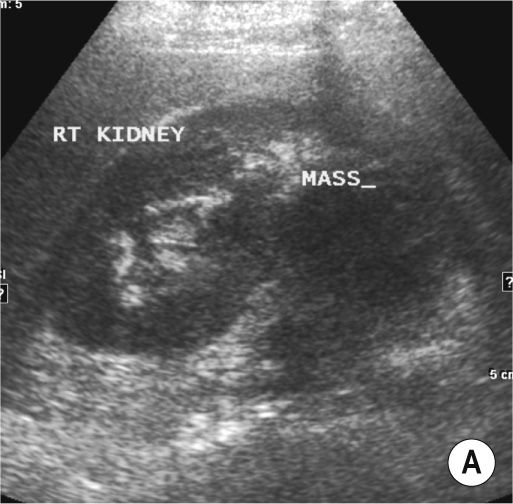
Replacement of the normal transitional epithelium by squamous epithelium (which may become keratinized) ▸ it is associated with recurrent urinary tract infections and calculi
Areas of squamous metaplasia seen as sharply defined white patches on the renal pelvic mucosal surface ▸ it appears as thickened folds and irregularity of the renal pelvis
A rare chronic granulomatous infection usually affecting women (secondary to E. coli infection) and which is more common in immunosuppressed patients ▸ small plaques are visible on the mucosal surfaces (bladder > upper urinary tract)
Multiple small filling defects within the renal pelvis and ureter (they are too small to be seen within the bladder)
Focal hypoechoic renal masses – these may become large enough to mimic a tumour ▸ there may be impaired renal function if the parenchyma is involved
A mass of desquamated keratin lying free within the lumen and demonstrating a typical whorled appearance
Small benign submucosal cysts of the renal pelvis and ureter ▸ it is associated with urinary tract infection and chronic obstruction
Multiple small filling defects indenting the renal pelvis and ureter
This is due to a fluke infestation ( Schistosoma haematobium ) ▸ the worm enters the skin and matures within the liver (via the portal vein) ▸ ova are then deposited within the bladder or ureteric submucosa (via the perivesical plexus) ▸ the ova produce an inflammatory reaction, leading to granuloma and stricture formation
These are grossly dilated and tortuous (± strictures) ▸ there can be multiple filling defects (representing granulomas or ureteritis cystica) ▸ parallel lines of ureteric calcification can be seen
This is small and fibrosed with wall calcification (which can be fine, granular, linear or irregular)
Bladder squamous cell carcinoma (with chronic infection)
An opportunistic infection (often C. albicans ) due to the increased use of antibiotics, immunosuppressive agents and steroids ▸ diabetics are at increased risk
A round, shaggy (sometimes laminated) fungus ball within the renal pelvis or bladder (it may extend into the ureter as a cylindrical filling defect) ▸ it is highly echogenic on US, and it may demonstrate air within the collecting system and bladder
Pus within the renal pelvis and calyces following an ascending infection in an obstructed kidney (e.g. secondary to a calculus or PUJ obstruction) ▸ there is a risk of septicaemia and endotoxic shock (especially with attempted drainage)
An obstructed kidney ▸ debris or gas (dense shadowing) within the renal pelvis ▸ cortical loss or a perinephric abscess if long-standing
High-density material (± layering) within a dilated pelvicalyceal system ▸ there may be a renal or perinephric abscess ▸ thickening of the renal pelvis (>2 mm)
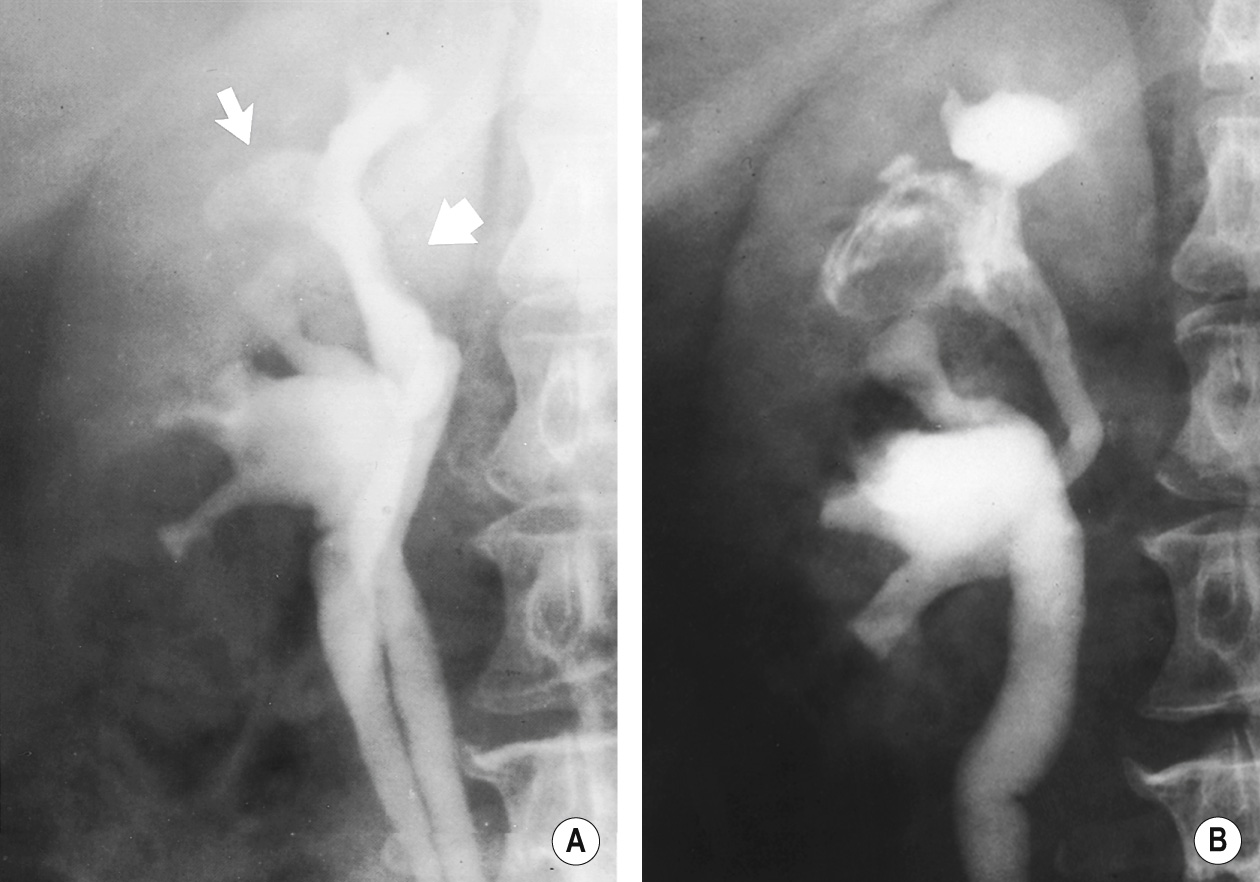
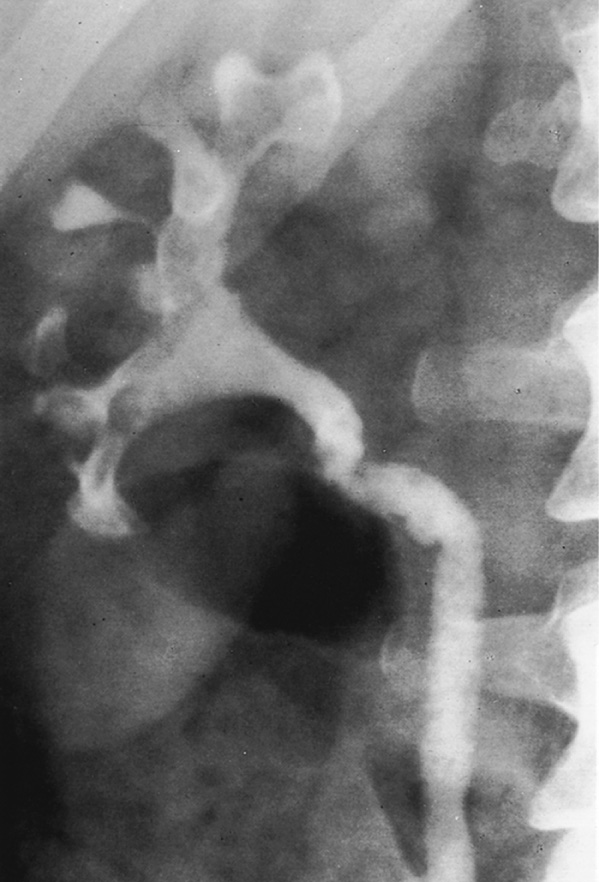

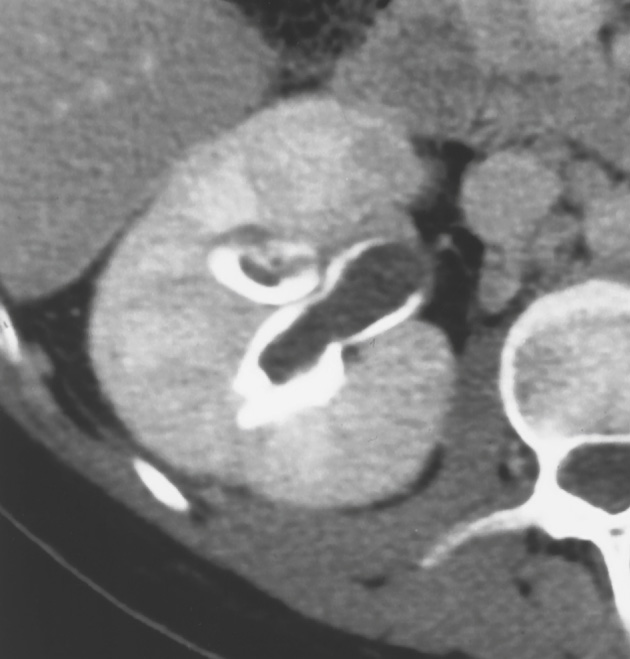
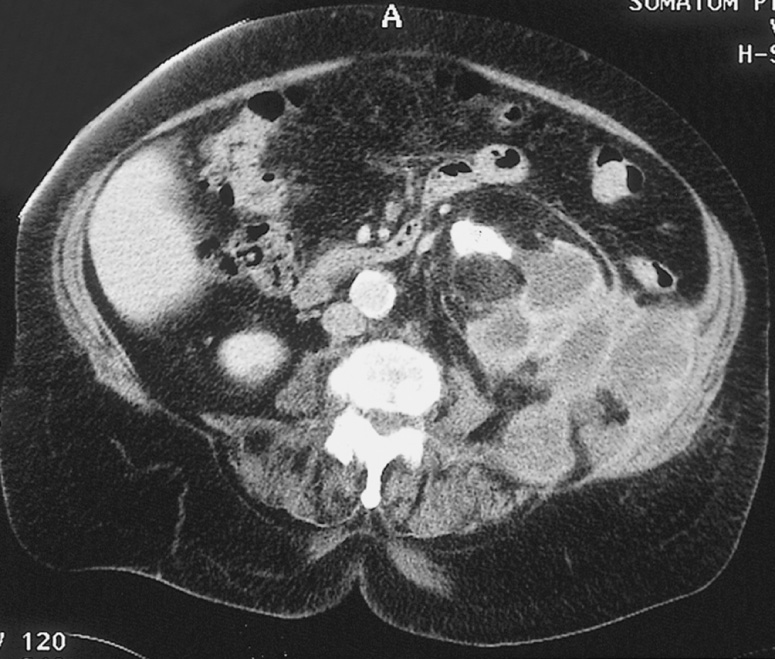
Narrowing of the renal artery accounts for 1–5% of all causes of hypertension
Mechanism: decreased glomerular perfusion results in renin release via the juxtaglomerular baroreceptors ▸ the resultant increased renin (and angiotensin II) levels leads to vasoconstriction
This is the commonest cause of RAS (70–80%) and is most commonly seen in men over 50 years old ▸ atheroma involves the origin (ostial) or proximal ![]() of the renal artery ▸ there can be post-stenotic dilatation
of the renal artery ▸ there can be post-stenotic dilatation
Ostial lesions are caused by aortic plaques ▸ renal arterial lesions are caused by eccentric atheromatous plaques of the proximal renal artery
This is the most common cause of a non-atheromatous RAS and is the 2 nd most common cause of an RAS (15–20%) ▸ it typically occurs in young women
Medial fibroplasia is the commonest form, causing multiple short stenoses (with a ‘string of beads’ appearance on angiography)
It involves the distal main renal artery (and its major branches) ▸ it can also affect the external iliac and carotid arteries
It dilates easily with excellent angioplasty results
This is a rare disease affecting the aorta and its branches ▸ aortic disease may consist of diffuse or focal stenoses, occlusion, or a fusiform AAA ▸ can be resistant to dilatation
In the absence of any other renal disease, a significant discrepancy in renal size should suggest the presence of RAS
Become a Clinical Tree membership for Full access and enjoy Unlimited articles
If you are a member. Log in here